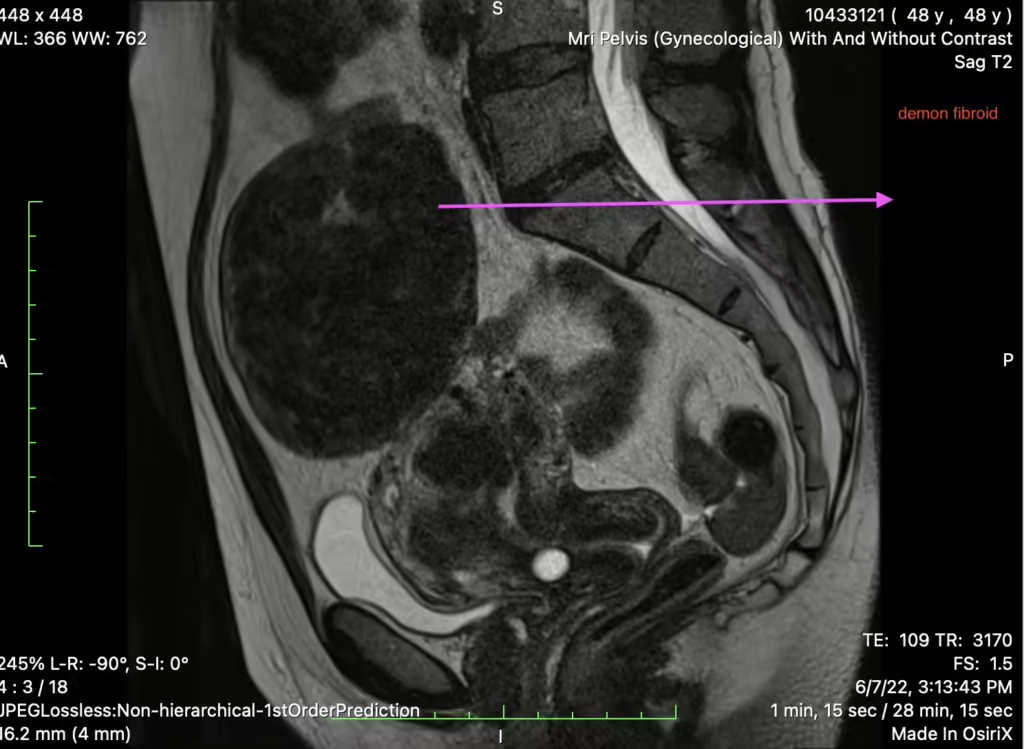
I Almost Died Because I was Gaslit
TLDR: I almost died because doctors dismissed my crime scene periods as “normal for my age”, told I was in perimenopause and should wait it out or get a hysterectomy. Turns out I had fibroids (one which ended up being 16cm when seen on an MRI).
I almost died from hemorrhaging and ended up with two separate fibroid surgeries in my quest to save my uterus.
Gaslit. Misdiagnosed. Ignored. With a shitty quality of life for nearly 7 years.
What happened to me is happening to millions of other women in their 40s.
It’s the reason I wanted to start Rêve Health. Both my Co-Founder Maddy and I were gaslit by doctors despite very real illnesses and issues.
Today is Thanksgiving and I am grateful to be alive.
I want to empower women to take back control of their health, and it starts by telling my story.
“Am I Hemorrhaging to Death?”
The entire 15 minutes in the Uber (from my house to the doctor’s office) I thought I would bleed out. I was anemic, and weak–that was par for the course. I was used to feeling light-hearted, fatigued, and moody. The past 18 days I had been bleeding.
Usually, it was just one or two awful days of my “period.” The rest of the time, sometimes another 3 weeks, it was bad but not that bad. I had been to numerous doctors over the years who told me everything was normal, and to wait it out until menopause. I was told I had low estrogen and should go on HRT.
But it turns out I had a 16cm fibroid (which is like, hitting the jackpot of fibroids) surrounded by smaller fibroids.
I had high estrogen.
None of it was normal.
I discovered all this on March 31, 2022, the day I nearly hemorrhaged to death.
Today I could feel the clots–the size of golf balls—coming up one after an another and the flooding of blood, like a water pitcher.
I wondered if it was my last day.
I opened the notes in my iPhone and wrote, “Am I hemorrhaging to death?”

Yes, I Was
I don’t remember exactly how I got out of the car, past security at the hospital where my doctor had her office, or into the doctor’s office (and somehow, also, had put a covid mask on my face).
I do remember yelling about needing a bathroom, being ushered into one, and sitting there for a long time. Gushing blood.
“Are you ok in there???” A concerned and kind voice on the other side of the door called out.
“No,” I piped as I scanned the room; it was reminiscent of a crime scene in “Dexter.”
15 minutes later I was getting an ultrasound. It turns out I was, in fact, dying.
A half hour later I was being asked to sign papers for an emergency hysterectomy.
10 hours later I woke up from general anesthesia (uterus intact).
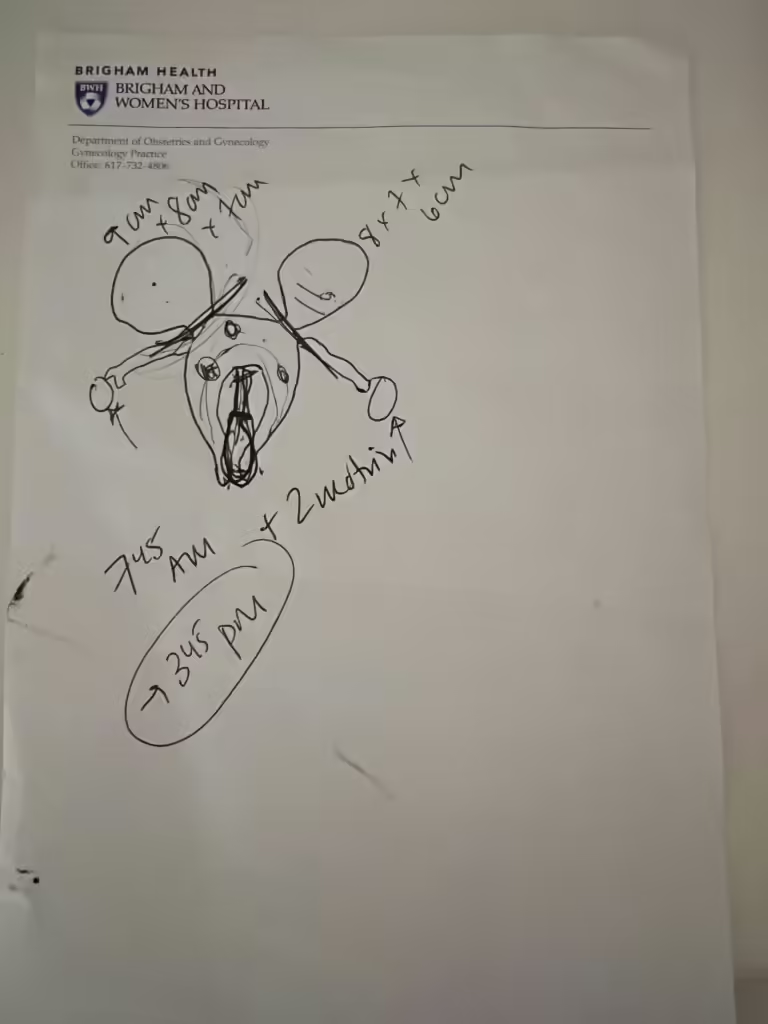
Let’s Take a Moment to Pause
Because that’s what I had to do.
I was sitting on a towel, on a brutalist chair in my doctor’s office.
My surgeon put together a drawing for me on a pass of paper that looked like Mickey Mouse.
She explained that the two huge ears represented pedunculate fibroids—attached to, but outside of the uterus, the mouse face was my uterus itself, and the “nose” was an egregious fibroid that apparently was trying to birth itself.
The ultrasound—which was a rather messy experience, also reminiscent of Dexter (they needed a mop down on L3 where the ultrasound took place) showed a uterus full of fibroids.
But one, was hanging by a thread (not the medical term) and it was coming out.
My doctor, who also happens to be a surgeon, placed papers in front of my face and handed me a pen.
“You need a hysterectomy,” she said, “here’s the paperwork to sign…you’re going into to a surgery in a few hours…you can call or text someone to pick you up tomorrow.”
I became a machine, half-listening to my doctor whole googling (she was saying something about permanent relief, something about me being 48 and not having or wanting kids and anyway it was too late…).
It didn’t matter what she was saying: I was already on a mission.
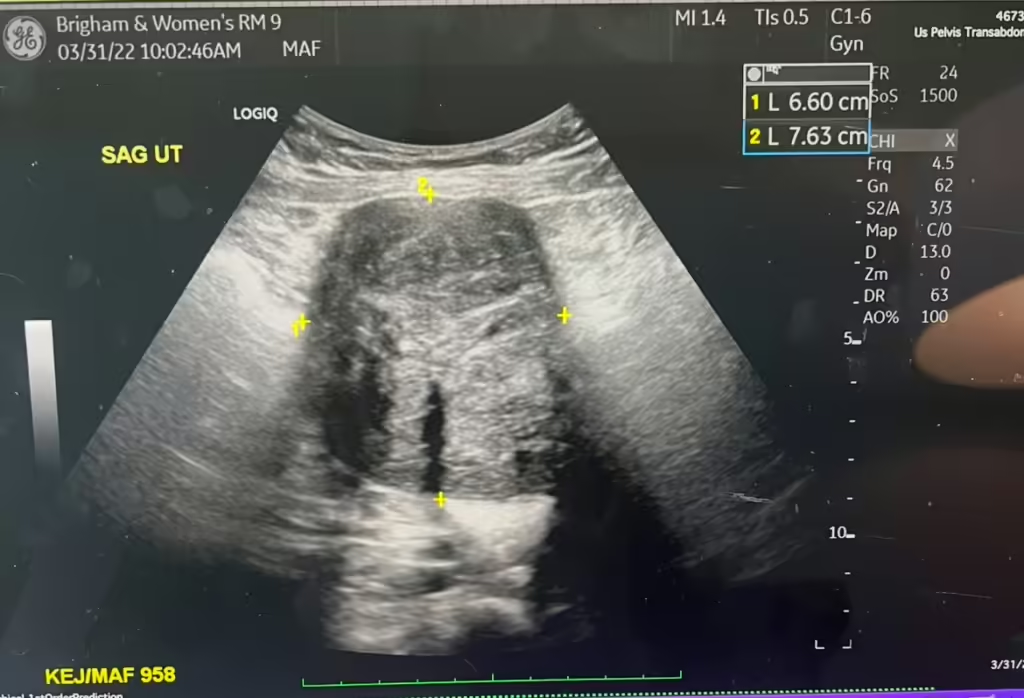
The Stats: 90% Of Hysterectomies are NOT Necessary
In less than 2 minutes of rabid Gen-z worthy phone skills,
I learned that:
Out the 500,000+ hysterectomies performed every year in the U.S., only 90% are necessary (the ones for cancer or other life-threatening diseases);
That it was not uncommon to have:
vaginal prolapse
organ displacement
lack of sexual pleasure
no sexual pleasure
rapid aging (links to shortening telomeres which has a direct effect on our biological age)
immediate chemical menopause (even if the ovaries are preserved)
weight gain
depression
anxiety
…after a hysterectomy.
I learned hysterectomies are the blanket recommendation for uterine issues in midlife despite efficacy of less invasive surgeries or alternative treatments.
I learned that Chinese Herbs and acupuncture were known to be effective at reducing fibroid size.
It was possible I’d be looking at Hormone Replacement Therapy (HRT) for the rest of my life. I never reacted well to the birth control pill and wondered what other hormones might do.
This was not looking like the master cure of all time.

The Quest to Save a Uterus
There’s a condition called “white coat effect,” and it refers to people getting nervous in front of doctors. White coat syndrome, or white coat hypertension, is the term for when you get a high blood pressure reading in a doctor’s office and a normal reading at home.
The anxiety of being around doctors in white coats can make your blood pressure rise. Sometimes it means we suppress our own gut instinct out of respect for the authority in the room.
Being overwhelmed and simple deferring to their recommendations is common. When your blood pressure rises you can’t think straight. It’s a legitimate syndrome.
I was nervous, but I also knew I was not ready to have a hysterectomy.
“Listen,” I interrupted my doctor. “I do not want a hysterectomy. What can be done today?”
My doctor looked at me. I wondered if she was trying to decide if she would go all authoritarian on me and inform me about her years in medical training, but instead she approached it with empathy.
“I might be able to do a myomectomy and remove that one fibroid. We have to do it today.
We can address the rest of them at a later point in time–you’ll need another surgery!
I need you to know there’s a chance, if you’re bleeding too much I’ll have to do a hysterectomy. But I will do everything in my power to avoid it.
Does that work for you?”
Yes it did.
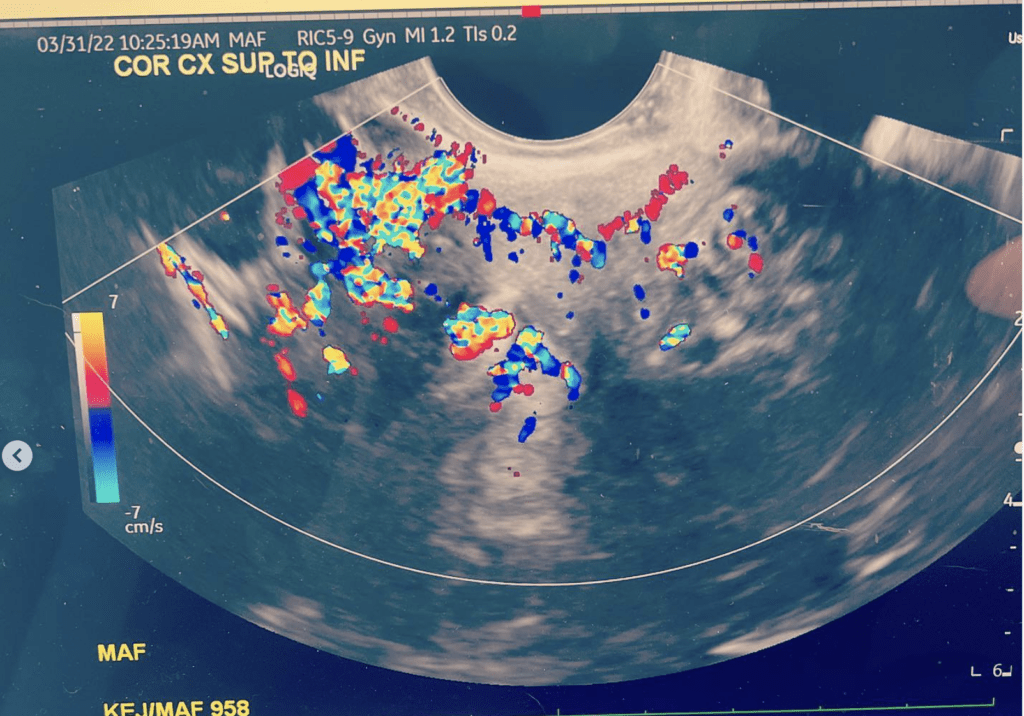
YOU Are Your Own Advocate
Women are gaslit by doctors—more than 90% of us report feeling ignored and dismissed by doctors. And I’ve written blogs about this phenomenon (hint: it is NOT all in your head).
Women who speak up about things are often disliked, even by other women (I believe it is because we don’t know how to advocate for ourselves and get frustrated when we see others doing that).
But my doctor that day listened. She heard me, after 7 years of not being heard.
I believe I tapped into something with her that day: her desire to help and heal and to listen to a woman who has crystal clear about what she did not want to do.
That same day, 8 hours later, I woke up from surgery groggy in the basement of a Boston teaching hospital.
The first question I asked was whether I still had my uterus.
I did.
My nurse told me I had a team of all women during my surgery and every single one was working to save my uterus.
There is much more to my story, including the 6 months I spent attempting to avoid a second surgery for the remaining fibroids. But that’s a story for another day.
Perimenopause, or…?
In the United States, there are approximately 20.5 million women aged 45 to 54, an age range that generally overlaps with the typical years of perimenopause, which commonly occurs in the late 40s to early 50s, but can start as early as 35 and go until late 50s (yep, some women don’t get menopause until nearly 60).
Almost EVERY single one of these ladies experiences some sort of unruly symptom, as we rollercoaster toward menopause.
Heavy periods
Hair loss
Brittle nails
Weight gain
The “menopot” belly
Fatigue
Cold sweats
Anger/Rage
But here’s the thing: is this new diagnosis of perimenopause hurting us?
While the terminology brings awareness to this part of life…are women in their forties just told everything wrong is perimenopause without further examindation?
Are we being written off without any real research into the underlying cause for all these issues? I think, yes. Certainly in my case and in the dozens of stories I’ve heard from friends.
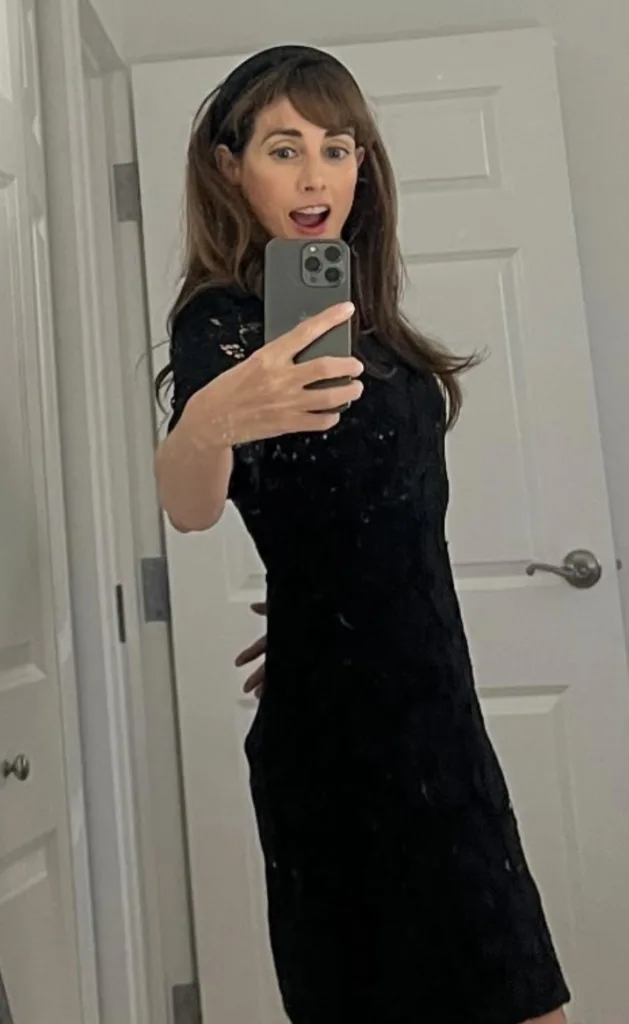
YOU Are Your Own Advocate
I’m kind of over this perimenopause terminology, because the reality is, I have NO symptoms of it right bow after major lifestyle changes, and my crime scene periods were caused by fibroids and high estrogen, NOT low estrogen and NOT entering menopause.
If I had done HRT when first “diagnosed” with perimenopause at 42, I would have made my fibroid family even larger.
If I had gotten bloodwork or an ultrasound, I would have known I had high estrogen and major hormonal imbalances.
I would have known I had fibroids—which more than 70% of women over 40 have.
And if I had known about my issues, I could have resolved them without any surgery.
More important, I wouldn’t have suffered for nearly 7 years.
I am 51 years old and honestly, my best life is just getting started. But I suffered, for a very long time. And now my greatest wish is that no other woman goes through what I did.
On December 10, 2024 I will be hosting a webinar on perimenopause…and whether it actually is perimenopause, or something else.


